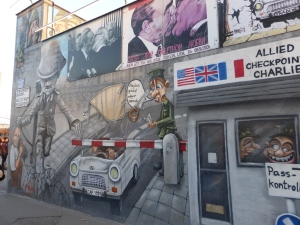
I grew up in a Germany that was split. I remember sitting in front of the TV with my grandparents. Some sporting event was going on. The East German Team won over the West German team. My grandparents were disappointed. Even as a naïve 9-year old I understood that this “DDR” was different from the other countries.
Living close to the river Elbe I was used to the sight of watchtowers and barbed wire on the other side, boats patrolling right in the middle of the Elbe, East Germans and West Germans eying each other suspiciously. As children, we found it exciting to watch. We were good, the others were bad, it was a game to us. We did not understand yet that people were killed at this border.
Later, when I had learned about German history in school, had started reading newspapers and developed a kind of political awareness I understood that the border was wrong, but I didn’t care so terrible much. Life was good; I was growing up and found it exciting to take the train oder transfer road to Berlin, always wondering whether we would be stopped by the ‘Vopos’, the DDR-police. There were a lot of stories going around how they were demonstrating their power and accusing people of spying.
Once, when we were on a day trip to East-Berlin, we went into a restaurant which was crowded. We asked some people at a bigger table if they would mind if we sat down. They didn’t. A few minutes later a waiter appeared and asked them to join a table at the other side of the restaurant. We ate alone. The food was lousy. We understood what had happened.
A few years later a revolution took place. East German people became heroes. They protested peacefully. They forced their Government to let them travel freely. And finally the wall fell. Not long after, Germany was reunited. We watched all this on TV, talking about it but it first became real when the long lines of tiny Trabbis came into Hamburg, the shops being as full as never before. I admit, after a while, I felt a bit annoyed when I more than once found that the nappies and bananas were sold out in our local “Aldi-store”.
We took day trips into East Germany, feeling shocked when we saw the run down houses. Everything seemed dark and gray, no advertisement, no big shop windows, huge fields, terrible roads. I imagined that this must have been what Germany looked like in the early 50ies.
Not long after, I was teaching German at that time, we got new colleagues from East Germany. They had strange habits. Having schnapps with their coffee in the middle of the day. And being much stricter than us West-German teachers. They accepted lower wages than us and we were worried that the old staff would soon be replaced by cheaper staff from the East.
The institution I was working at was offering German courses for refugees and immigrants from Russia and Poland and, in 1991 integration classes for people from East Germany. In these classes we taught how the West German system worked, how to apply for jobs and offered assistance searching for work. I was working as a social worker in these courses and I remember many sad cases. Marriages that had broken up, fathers that had gone to the West leaving the wives and kids behind, people being lost in the West German bureaucracy, and, many, many East Germans that had been talked by West Germans salesmen to buy insurances they didn’t need or expensive knickknacks they couldn’t afford.
I met men and women that were disoriented and disillusioned, who had not learned yet that freedom has its challenges and requires an enormous amount of looking after yourself, something they had not learned in their state. Having to search for after school day-care of your own in a state that had a profound lack of such places, being confronted with an unemployment rate that didn’t exist where they came from, competing over flats with many other people, having offers to buy just about anything on credit, but having no job security were conditions that were until then unknown to them.
Most East Germans that came to the West integrated quietly, but at our institution we were confronted with the ones that had difficulties to adjust. Many had worked in jobs that didn’t exist in West Germany, and coming to the West, realizing there was no place for them hurt and disillusioned many. It was sad to watch.
I stopped working in that institution when my second son was born. He was born on the 3rd of October, 24 years ago. He and his brother have grown up in a united Germany. For them Leipzig and Chemnitz are German cities just like Hamburg and Köln. They never thought in categories like East (bad) and West (good).
The first years were not easy, turning two different systems into one. I believe that it must have been harder for East Germans as they had to make much bigger adjustments. We West Germans sometimes overlooked that we could learn from them, too. But that is a different story. Today, I simply feel happy and glad; that Germany is one. While being focused on my own life and worries, historical events took place.
Today, we can travel to Poland and Czechia, to Latvia and Estonia and many, many other places that were once cut off through the “iron curtain”. Our world has changed enormously during the last 25 years and it will continue changing. But those of us, who have lived through those changes, now know that there are chances in new and unknown situations and that, if everyone participates it is possible to turn the world into a better place.
